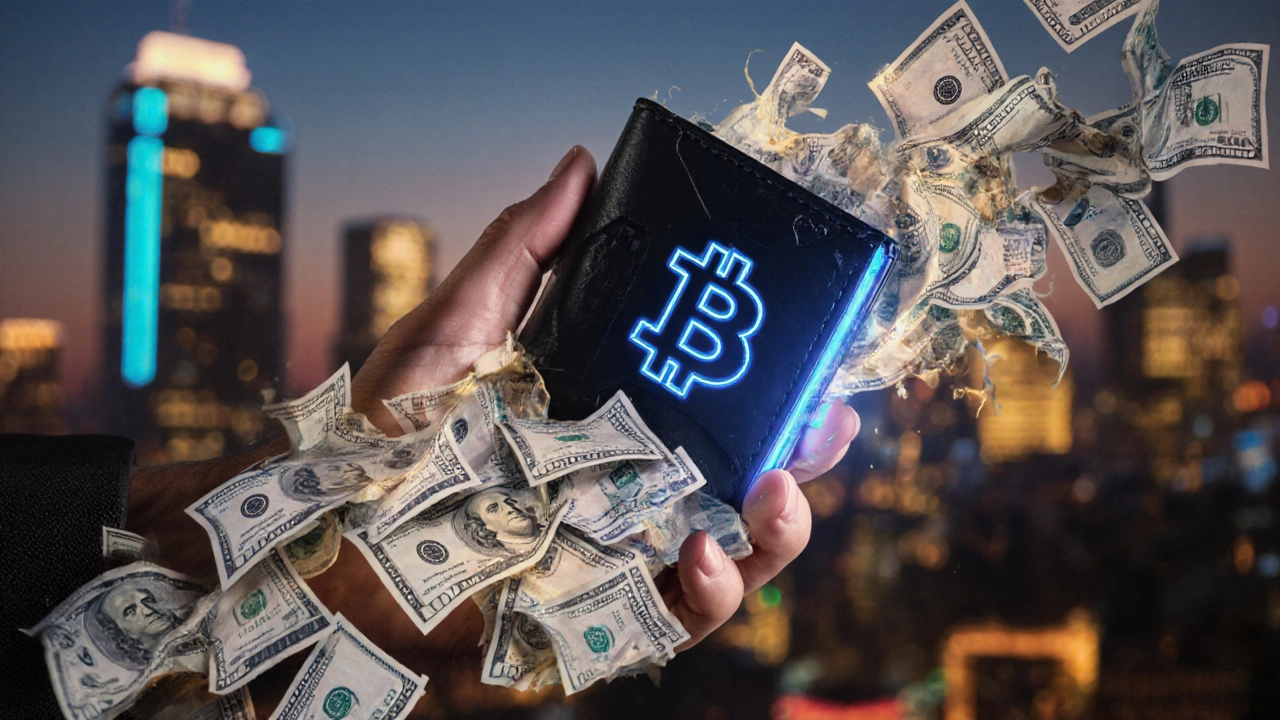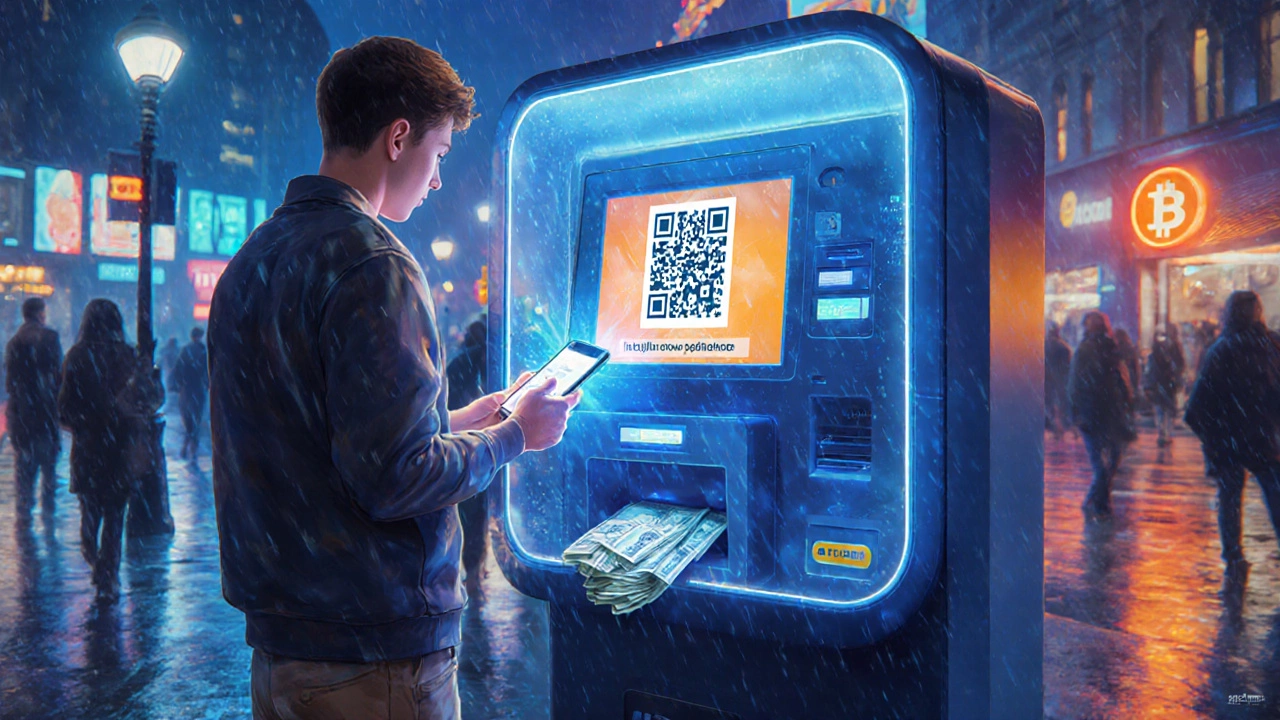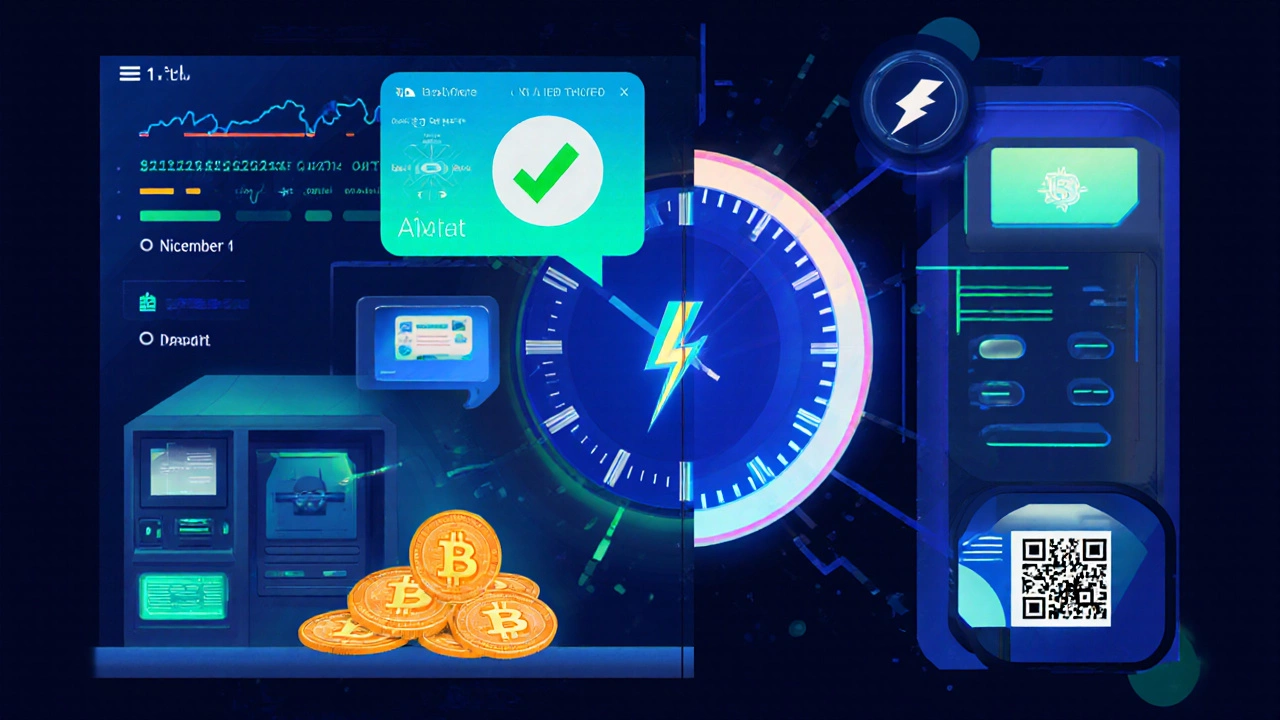How to Cash Out Bitcoin Instantly: Fastest Methods Explained
 Oct, 8 2025
Oct, 8 2025
Bitcoin Cash-Out Speed Calculator
Exchange + Debit Card
10-30 minBest for larger amounts with reliable limits
Fees: 1-3% + $0.30
P2P Platform
Seconds-5 minFastest for small amounts
Fees: 0-2% (buyer-paid)
Debit Card Service
5-15 minQuick setup, moderate fees
Fees: 2-4%
Bitcoin ATM
2-5 minCash in hand, higher fees
Fees: 5-10%
Lightning Network
InstantLow fees, requires compatible wallet
Fees: ≤0.5%
Estimated Results
Amount:
Method:
Estimated Time:
Estimated Fees:
Net Amount:
Notes:
Want to turn your Bitcoin into cash this minute? You’re not alone-many people wonder if they can cash out Bitcoin instantly without waiting days for a bank transfer. The short answer is yes, but the exact speed depends on the route you take, the amount you want, and how much verification you’ve already completed. Below we break down the fastest ways to liquidate Bitcoin, what you need to prepare, and the trade‑offs you’ll face.
What "cash out" Really Means
In crypto speak, cashing out is simply selling Bitcoin for a fiat currency (like USD, EUR, or CAD) and moving that money into a traditional account or getting physical cash. The process usually involves three steps: sell, convert, and withdraw. Speed hinges on how quickly each step can be completed.
Key Players in Instant Bitcoin Liquidity
Before we dive into methods, let’s introduce the main entities you’ll encounter. The first time each appears we wrap it in microdata so search engines can surface the facts.
Bitcoin is a decentralized digital currency that operates on a peer‑to‑peer network, allowing users to send and receive value without a central authority. Its ticker symbol is BTC.
Cryptocurrency exchange a platform where you can trade digital assets for fiat or other cryptocurrencies. Think of Coinbase, Kraken, or Binance.
Peer-to-peer (P2P) platform a marketplace that matches buyers and sellers directly, often allowing multiple payment methods. Examples include LocalBitcoins and Paxful.
Bitcoin ATM a physical kiosk that lets you sell Bitcoin for cash on the spot.
Lightning Network a layer‑2 scaling solution that enables near‑instant Bitcoin payments with low fees.
KYC (Know Your Customer) verification procedures required by most regulated services to confirm user identity.
Bank transfer an electronic movement of funds between financial institutions, typically taking 1‑3 business days.
Fiat currency government‑issued money such as the US dollar, Euro, or Canadian dollar.
Method 1: Instant Withdrawals via Major Crypto Exchanges
Most regulated exchanges let you sell Bitcoin and withdraw to a linked debit card in minutes. Here’s a typical flow:
- Complete KYC on the exchange (if you haven’t already). This usually takes a few minutes with a photo ID and selfie.
- Transfer Bitcoin from your wallet to the exchange’s deposit address. Network confirmations can be as fast as 1‑2 minutes on a low‑fee transaction.
- Sell the Bitcoin for your desired fiat at the market price.
- Select the “instant card payout” option. The cash appears on your debit card within 10‑30 minutes.
Popular services offering this include Coinbase Cashout, Binance Card, and Kraken Instant Withdrawal. Fees range from 1‑3% plus a small card‑processing charge.
Method 2: Peer‑to‑Peer Platforms with Cash‑by‑Hand or Instant Bank Transfer
P2P sites let you pick a buyer who’s willing to pay instantly through a payment method you trust. Steps:
- Post a sell order specifying the amount, price, and payment method (e.g., PayPal, Zelle, or cashin‑person).
- When a buyer accepts, the platform holds the Bitcoin in escrow.
- You receive the fiat payment and, once confirmed, release the Bitcoin.
Because the buyer sends money directly to you, the cash can be in your bank account within seconds (instant‑transfer apps) or in your hands if you meet locally. However, P2P trades expose you to fraud risk, so only use platforms with escrow and reputation scores.

Method 3: Debit‑Card Conversion Services (BitPay, Simplex)
Some fintech providers act like a bridge between crypto wallets and traditional cards. The workflow is similar to exchanges but often bypasses the need for a full‑blown account:
- Enter the amount of Bitcoin you want to sell.
- Provide your debit card details. The service performs instant KYC using your card data.
- Funds are credited to your card in under 15 minutes, ready to be spent or withdrawn at an ATM.
The upside is speed and minimal setup. The downside is higher fees (typically 2‑4%).
Method 4: Bitcoin ATMs for Physical Cash
Bitcoin ATMs are scattered across major cities. To sell Bitcoin for cash:
- Locate a “sell‑only” ATM using a service like CoinATMRadar.
- Scan your wallet QR code to send Bitcoin to the machine’s address.
- Confirm the transaction; the ATM dispenses cash once it sees the required confirmations (usually 1‑2).
Most ATMs impose limits (often $1,000‑$2,500 per transaction) and charge 5‑10% fees, but they give you cash in hand within minutes. Availability varies by region, so check Canadian locations if you’re in Toronto.
Method 5: Lightning Network Payments to Fiat‑Enabled Services
The Lightning Network makes micro‑payments settle in seconds. A handful of services (e.g., Strike, LightningBank) let you receive Lightning payments and instantly convert them to fiat, which then lands in a linked bank account.
Process:
- Open a Lightning wallet (e.g., Phoenix or Breez).
- Send Bitcoin into the Lightning channel.
- Use the service’s UI to swap the Lightning balance for USD/EUR/CAD.
- Withdraw instantly to a prepaid card or bank account.
Fees are low (under 0.5%) and settlement is near‑instant, but you’ll need a compatible wallet and the service must support your country’s banking system.
Factors That Slow Down a Cash‑Out
- KYC status: New accounts often face manual review, adding 30‑60minutes or longer.
- Network congestion: During peak times Bitcoin’s on‑chain confirmations can take 10‑20minutes, affecting exchange deposits.
- Banking hours: Traditional ACH transfers only process on business days, so even a “fast” method may fall back to next‑day settlement.
- Geolocation restrictions: Some services limit instant payouts to specific countries or require local bank accounts.
- Transaction size: Very large withdrawals may trigger additional compliance checks, slowing the process.
Quick Checklist for the Fastest Cash‑Out
- Complete KYC on at least one trusted exchange or P2P site.
- Link a debit card or bank account that supports instant transfers (e.g., Interac e‑Transfer in Canada).
- Keep a small amount of Bitcoin on a mobile wallet for rapid on‑chain sends.
- Know the fee structure of each method-instant usually means higher cost.
- Test with a modest amount first to confirm the speed and reliability of your chosen route.

Comparison of Instant Cash‑Out Options
| Method | Typical Speed | Fees (approx.) | Max per transaction | Verification needed |
|---|---|---|---|---|
| Major exchange + debit card | 10‑30min | 1‑3% + $0.30 | $10,000+ | Full KYC |
| P2P platform (instant bank transfer) | Seconds‑5min | 0‑2% (buyer‑paid) | Varies by buyer | Basic ID (platform‑dependent) |
| Debit‑card conversion service | 5‑15min | 2‑4% | $5,000 | Quick KYC (card) |
| Bitcoin ATM (cash) | 2‑5min | 5‑10% | $2,500 (per ATM) | Phone verification (often) |
| Lightning‑enabled fiat service | Instant (seconds) | ≤0.5% | $1,000‑$5,000 | Basic ID + wallet |
Common Pitfalls and How to Avoid Them
Skipping KYC and then getting locked out. Most instant services require at least a verified ID. Finish this step early, even if you’re only testing with a small sum.
Choosing the cheapest method over speed. Low‑fee P2P trades can be slow if the buyer uses a bank that processes only during business hours. Match the method to how quickly you need cash.
Ignoring network fees. During congestion, on‑chain fees can spike, delaying the deposit to an exchange. Use a higher fee or opt for Lightning when possible.
Real‑World Example: Cashing Out $2,000 in Toronto
Emma lives in Toronto and wants cash for a weekend market stall. She follows these steps:
- She has already verified her identity on Coinbase.
- She transfers 0.055BTC (≈$2,000) from her hardware wallet to Coinbase; transaction confirms in 3minutes.
- She sells at market price and selects the “instant debit card payout” option, linked to her Interac‑enabled Visa debit card.
- Within 12minutes, $1,980 lands on her card. She withdraws the cash at a nearby ATM and is ready for the market.
If Emma needed cash in seconds, she could have used a local Bitcoin ATM, but the fees would have been around 8%, dropping her net to $1,840.
Bottom Line: Choose the Right Tool for Your Timeline
Instant cash‑out is absolutely possible, but the best path depends on three things: how fast you need the money, how much you’re selling, and how comfortable you are with fees and verification. Exchanges give you reliability and high limits; P2P platforms can be lightning‑quick for small amounts; ATMs hand you paper money on the spot; and Lightning‑enabled services combine speed with low fees for tech‑savvy users.
Frequently Asked Questions
Can I cash out Bitcoin to cash without an exchange?
Yes. Peer‑to‑peer platforms, Bitcoin ATMs, and Lightning‑enabled fiat services let you sell directly without a traditional exchange. Each method has its own speed, fee, and risk profile.
How long does a Bitcoin ATM transaction take?
Typically 2‑5minutes. You send Bitcoin, the machine waits for 1‑2 confirmations, then dispenses cash. Availability and limits depend on the specific kiosk.
Are instant cash‑outs risky?
Risk varies by method. Exchanges and reputable services have strong security but require KYC. P2P trades can expose you to fraud if you skip escrow. Always verify the counter‑party and use platforms that hold funds in escrow.
What fees should I expect for an instant cash‑out?
Fees range from under 1% (Lightning services) to 10% (some ATMs). Card‑linked exchange withdrawals usually sit around 1‑3% plus a small processing charge. Check the fee breakdown before confirming.
Do I need a bank account to cash out instantly?
Not always. Bitcoin ATMs give you cash outright, and some P2P deals let you receive money via cash‑in‑hand. However, most fast card payouts still require a linked debit or prepaid card, which is essentially a bank‑connected account.
